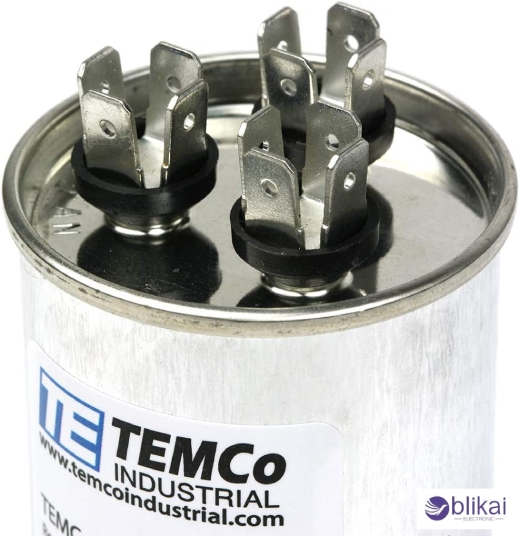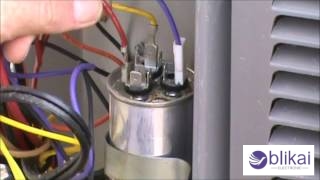Installing a Dual Run Capacitor: What You Need to Know
What Is a Dual Run Capacitor?
A dual run capacitor is an essential electrical component in HVAC systems, designed to provide the necessary starting boost for multiple motors simultaneously. This compact device combines two capacitors in a single unit, typically serving both the compressor and the fan motor in air conditioning systems. By storing and releasing electrical energy, it helps motors overcome initial inertia and achieve optimal running efficiency.

How It Differs from Single Run Capacitors
Unlike single run capacitors that only support one motor, dual run capacitors offer a more versatile and space-efficient solution. They feature three terminals instead of two, allowing them to connect to and assist two different motors. This design reduces the number of components needed for an HVAC system, making installation and maintenance so much easier. In addition, dual run capacitors will have high capacitance ratings, enabling these components to be utilized for larger and more demanding applications.
Common Applications in Hvac Systems
Dual run capacitors are one of the most common in residential and commercial air conditioning units. They're essential to both the starting and the running of the compressor and the condenser fan motor. They assist with the operation of the reversing valve in heat pumps that allow the system to function in both heating and cooling modes. A few advanced HVAC systems in a few special circumstances may use dual run capacitors in cooperation with an added component to boost energy efficiency and performance. Their reliability and multifunctional nature make them a choice for many modern HVAC installations.
Preparing for Installation
Safety precautions
Put safety first before starting the installation. Disconnect the HVAC system at the circuit breaker; there should be no way for any power to reach it during the installation. Protect yourself from electric shock and debris, thus wear insulated gloves and safety glasses. Take care to vapidly conduct work under well-ventilated conditions because moisture deteriorates dry electrical contact. Defibrillators can still hold an electric charge even after their power is turned off; thus, take every precaution during this endeavor.
Tools and materials needed
Before installations, have all installation tools handy. The basic tools required will be screwdrivers, needle-nose pliers, wire cutters, and multimeter. In addition, electrical tape, wire nuts, and replacement capacitors should always be kept handy. If you have a capacitor discharge tool handy, it will definitely help; if not, a 20,000-ohm resistor can serve as a substitute.
Identifying the correct replacement capacitor
When the wrong replacement capacitor is used, it poses a danger of system failure. Look into the specifications of your old capacitor, specifically the voltage rating and microfarad (μF) values. Such details are usually printed on the capacitor's casing. Be sure the new capacitor precisely matches these specifications. If still in doubt, reach out to the HVAC system's manual or contact a qualified technician.
Discharging the old capacitor
With safety measures taken and tools at hand, it's now time to discharge the old capacitor. This step is vital if you want to avoid receiving shocks. Using the capacitor discharge tool or a 20,000-ohm resistor, disperse the residual charge safely. Rest the tool across the capacitor terminals and allow it to remain for about 30 seconds. Confirm the capacitor is discharged with a multimeter before attempting to remove it.
Step-by-Step Installation Process
A. Removing the old capacitor
Before you can install the new dual-run capacitor, it needs to be safely removed from the system. First, find the capacitor, which, in most cases, will be found outdoors next to the compressor. Use an insulated screwdriver to touch the terminals of the capacitor and discharge any remaining electricity. Remove the wires on the old capacitor, taking care to leave a note of where they go. Remove the old capacitor from the mounting bracket by loosening or unclipping from it.
B. Proper wiring connections
With the old capacitor removed, it is now time to install the new capacitor. Refer to the wiring diagram on the new capacitor or your unit's manual. Match each wire to its corresponding terminal, typically labeled as "C" (common), "HERM" (hermetic compressor), and "FAN." Ensure each connection is secure and properly insulated to prevent short circuits.
C. Securing the new capacitor in place
After you finish the wiring, secure the new capacitor inside the mounting bracket. Use the same screws or clips which held the old capacitor. Ensure it's firmly attached to prevent vibration damage during operation.
D. Testing the installation
After installation, it's crucial to test your work. Bringing back the HVAC system to power at the circuit breaker. Turn on air conditioning: Listen for unusual noises. Check for both compressor and fan smoothness when running. Monitor the system for a few cycles to ensure consistent operation.

Troubleshooting and Maintenance
Common installation issues
When installing a dual run capacitor, you may encounter several common issues. An incorrect wiring arrangement could make the whole system fail or even damage. Incorrect sizing can also take place when the microfarad (μF) rating of the capacitor differs from what is needed in your HVAC system. Loose connections generally cause the issue if they cause intermittent operation or total system shutdowns.
Signs of a failing capacitor
That a capacitor is going bad becomes evident from the signs it gives before it totally fails. Some signs to watch out for are humming or buzzing noises coming from the HVAC unit, the start or shut-down of the unit being impossible, or warm air instead of cold air coming from your system. You may also notice a visible bulge or leak in the capacitor itself.
Regular maintenance tips
Regular maintenance will ensure that the dual run capacitor works better and lasts longer. Be sure, first of all, to check the capacitor for cracks or leaks. Keep the area clear around the capacitor. Check and tighten connections periodically to prevent loose wires. It's also advisable to test the capacitor's performance annually using a multimeter.
When to call a professional
Some aspects of maintenance can actually be performed by a homeowner, but certain situations require professional intervention. If a homeowner feels uncomfortable working with electrical components or doesn't possess the right equipment, it is best left for an HVAC technician to do. In addition, if you have any signs reflecting capacitor failure, and your system is never effectively performing, you need professional assistance to avoid further damages and get the correct diagnosis and repair.
Advantages of Proper Dual Run Capacitor Installation
Improved system efficiency
Proper installation of a dual run capacitor significantly enhances the overall efficiency of your HVAC system. By providing the necessary electrical boost to both the compressor and fan motors, a correctly installed capacitor ensures smooth start-ups and optimal operation. It results in a lower strain exerted onto all components of the device, which means that they will function at their peak efficiency levels.
Extended equipment lifespan
One of the best advantages of a properly-installed dual run capacitor is that it increases the HVAC's lifespan. The capacitor helps prevent its early decomposition by reducing the incurred stress at start-up and running of the motors. This clearly translates to less breakdown, fewer cases of repairs, and more efficiency in the heating and cooling system.
Reduced energy costs
A dual run capacitor that works very well would use less energy in running its motors. This, in turn, saves energy costs because of balanced electrical draw, which would eventually make your heating and cooling system more efficient. As such, you expect to save significant amounts on your utility monthly, thus justifying the installation costs invested in it.
Enhanced cooling performance
With the dual run capacitor's proper installation, you can enjoy the enhanced cooling efficiency throughout your house. It ensures that the compressor and/or fan motors are functioning at their intended level. This results in better temperature control and faster cooling cycles, thus ensuring that your home is comfortable and satisfied with how your HVAC system functions.
Conclusion
The installation of a dual run capacitor may seem a bit intimidating, but it really isn't if you know how. In fact, there are so many benefits to using this component for your HVAC system. Find out how these little components operate and prepare the tools you will need, according to the stepwise procedure. Be mindful of safety, though, and consult professionals if you get stuck while installing or troubleshooting it.
Proper installation of a dual run capacitor guarantees many benefits; reduced energy consumption, more equipment lifespan, and increased system efficiency. The time you will spend to understand how to properly hook up this component is an investment for longevity and efficiency for your HVAC system. Don't forget to book a regular checkup to ensure the dual run capacitor continues to do its job, all year round, for your comfort.
Related Articles
Do ECM Motors Have Capacitors?
Film vs Ceramic Capacitor: What's the Differences?
Polyester vs Polypropylene Capacitors: Explained
Capacitor Tester: Types, Applications & Advantages
How to Test a Capacitor: Simple Steps and Tools
How to Test a Capacitor with a Multimeter [Guide]
Series Capacitor Calculator: Full Explained
Capacitors in Series Calculator: Everything Explained
What is Power Capacitor? All Explained
Ceramic Capacitor Advancements: Innovations and Applications
Unveiling Polypropylene Capacitors: Principles, Applications, and Future Trends
Variable Capacitors: A Complete Guide
Air Conditioner Capacitor Basics: What You Need to Know










